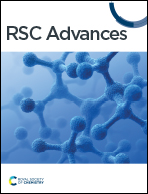Environmentally sustainable synthesis of whey-based carbon dots for ferric ion detection in human serum and water samples: evaluating the greenness of the method
Abstract
Carbon dots (CDs) are valued for their biocompatibility, easy fabrication, and distinct optical characteristics. The current study examines using whey to fabricate CDs using the hydrothermal method. When stimulated at 350 nm, the synthetic CDs emitted blue light at 423 nm and revealed a selective response to ferric ion (Fe3+) in actual samples with great sensitivity, making them a suitable probe for assessing Fe3+ ions. The produced carbon dots demonstrated great photostability, high sensitivity, and outstanding biocompatibility. The findings showed that Fe3+ ions could be quickly, sensitively, and extremely selectively detected in an aqueous solution of carbon dots, with a revealing limit of 0.409 μM in the linear range of 0–180 μM. Interestingly, this recognition boundary is far inferior to the WHO-recommended threshold of 0.77 μM. Two metric tools which were AGREE and the ComplexGAPI were also used to evaluate the method's greenness. The evaluation confirmed its superior environmental friendliness.



 Please wait while we load your content...
Please wait while we load your content...